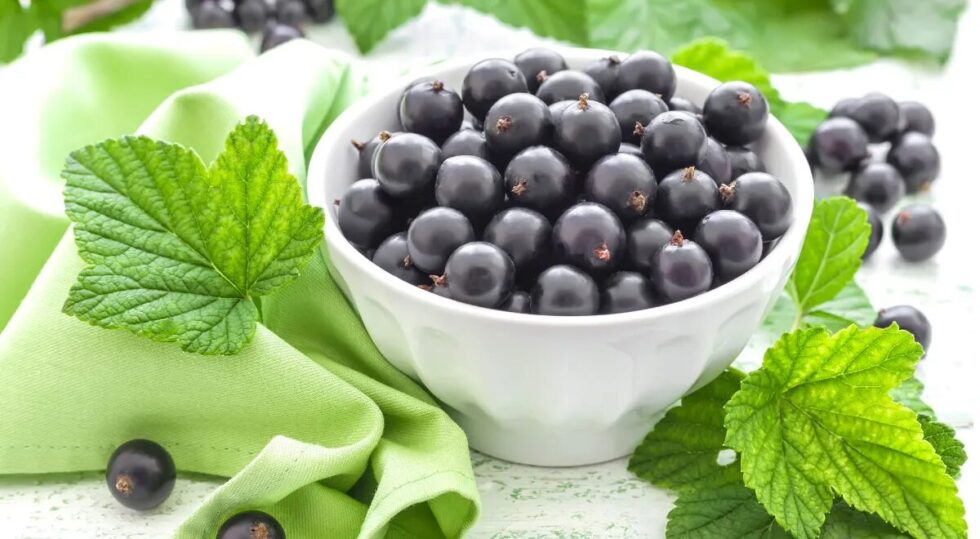Blackcurrant has long been considered one of the healthiest fruits cultivated in Europe, and in Germany it is enjoying a real comeback. Packed with vitamin C, anthocyanins and fibre, it plays an important role in both traditional recipes and modern health-conscious diets. In recent years, as demand for natural and locally grown products has increased, blackcurrant has earned the label of a “German superfood” – supported by scientific studies and growing sales of juices, jams and supplements. Cultivating it is relatively easy, but requires knowledge of soil, fertilisation and harvesting techniques. Moreover, it is a fruit that can be enjoyed in many ways – from fresh berries to homemade syrups and desserts. All essential details about its cultivation and nutritional benefits are covered below, prepared by our portal G.business.
Health benefits of blackcurrant
Blackcurrant boasts one of the highest vitamin C contents among fruits – up to 180 mg per 100 g, several times the daily requirement. It is also rich in anthocyanins, which have anti-inflammatory properties and support the immune system. Regular consumption can help improve circulation, support eye health and slow down ageing processes. In Germany, blackcurrant is valued especially in autumn and winter as a natural immune booster. Its fibre supports digestion, and its low glycaemic index makes it suitable for people with diabetes.
Key health benefits:
- Exceptionally high vitamin C content
- Antioxidants that fight ageing
- Improved circulation and heart health
- Strong immune support
- Low glycaemic index
How to plant blackcurrant in Germany
Blackcurrant thrives in most German regions, as it adapts well to a temperate climate. It grows best in fertile, slightly acidic soil (pH 6–6.5) that retains moderate moisture. Planting is done in autumn or early spring, leaving about 1.5 m between bushes. Choose sunny or semi-shaded locations for sweeter, more aromatic berries. Water regularly during dry spells and fertilise twice a year with compost or a potassium- and phosphorus-rich fertiliser.
Optimal growing conditions for blackcurrant in Germany
| Factor | Optimal conditions | Notes |
|---|---|---|
| Soil | Fertile, slightly acidic (pH 6–6.5) | Avoid waterlogged soils |
| Location | Sunny or partial shade | More sun = sweeter berries |
| Planting | Autumn or early spring | 1.5 m between bushes |
| Watering | Regular in dry periods | Especially when fruiting |
| Fertilisation | Compost, potassium-phosphorus mix | Twice a year |
Harvesting and storage
In Germany, blackcurrant usually ripens between mid-July and early August, depending on variety and region. Harvesting should be done on a dry day, when berries are fully ripe but still firm. Fresh berries can be stored in the fridge for up to 7 days, or frozen for up to a year without losing much nutritional value. Berries picked in full sun tend to have a higher sugar content and a more intense flavour. For larger plantations, harvesting whole clusters is common, as it facilitates transport and reduces damage.
Harvest tips:
- Pick on a dry day.
- Choose fully ripe fruit.
- Avoid crushing berries.
- Cool them quickly after picking.
- Freeze or process within a few days.
Where in Germany you can pick your own blackcurrants
A growing trend in Germany is Selbstpflücken – pick-your-own farms where customers harvest berries directly from the bushes and pay only for the weight. These farms can be found in many regions, especially in Lower Saxony, Brandenburg and Bavaria, where blackcurrant fields are common. Self-picking is often 30–40% cheaper than buying in shops, ensures maximum freshness, and lets you choose the best berries. Bring your own buckets or baskets and consider gloves for comfort. Many farms also offer other fruits, making it a perfect family outing.
How to enjoy blackcurrant
Blackcurrants can be eaten fresh, added to desserts, cakes, yoghurt or muesli. They are also popular in preserves – jams, jellies, juices, and even liqueurs and wines. With their intense flavour and aroma, they pair beautifully with meats, cheeses and modern fusion dishes. For weight-loss diets, blackcurrant smoothies are recommended: they provide fibre and vitamins with only about 50 kcal per 100 g. Dried blackcurrants are also available in health food shops as a nutritious snack.
Popular ways to use blackcurrant:
- Fruit smoothies with natural yoghurt
- Blackcurrant sauce for meats
- Homemade vitamin-rich juice
- Sugar-free jam
- Baked desserts with blackcurrant
Prices and availability in Germany
In the German season, blackcurrants are widely available at farmers’ markets, supermarkets and directly from growers. Fresh berries cost from around €5–€8 per kilogram at markets, and around €3–€4/kg in larger quantities from farms. Preserves such as juice or jam range from €3 to €8 per jar, depending on quality and brand. Self-pick farms often offer the best value, with prices around €2.50–€3.50/kg and guaranteed freshness.investment for your garden and your health.
In conclusion, blackcurrant stands out as one of Germany’s most valuable local superfoods, combining exceptional nutritional benefits with culinary versatility. Its high vitamin C content, antioxidant power and rich flavour make it a favourite in both traditional German recipes and modern healthy diets. With proper planting, care and harvesting, it can thrive in home gardens as well as on large-scale farms across the country. The growing popularity of self-pick farms shows that more Germans value freshness, local sourcing and seasonal eating. Whether enjoyed fresh, frozen, in juice or as part of a dessert, blackcurrant offers both health and taste in every serving. Investing time in cultivating or sourcing high-quality berries ensures you get the best of what this fruit has to offer year after year.
Stay connected for news that works — timely, factual, and free from opinion — and insights that matter now: Best Diets After 40: How to Lose Weight Without Harming Your Health.
